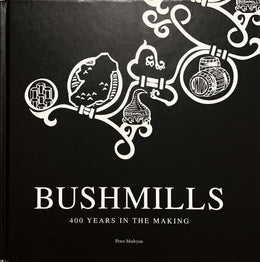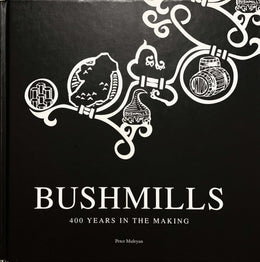


By the mid-1960s there was effectively just one working distillery left in Northern Ireland. In the Republic only three remained; John Jameson and John Power in Dublin and the Cork Distilleries Company —the stump of a once great industry.
The domestic market was contracting and exports were flat. The vast Victorian distilleries were expensive to operate and grossly inefficient. There was a huge duplication of resources and no one had enough money left to turn an Irish whiskey into a global brand.
With Old Bushmills then a part of the Charrington empire, John Clement Ryan, the last member of the Power family to work in the Dublin distillery, saw only one way forward: merger!

On 8th March 1966 John Power & Son, John Jameson & Son and the Cork Distilling Company put centuries of rivalry behind them and amalgamated to form the Irish Distillers Group (IDG).
For two years, for fear of offending any of the founding families, IDG survived without a Managing Director. Then in 1968 in a break with tradition, an outsider was appointed to the post. Kevin McCourt had just finished a five-year contract as Director General of the newly launched Irish TV service, RTE. He clearly learnt from the mistakes of the Dublin Whiskey Distillers (DWD) which had floundered in the early decades of the century. To survive, the Irish Distillers Group could not operate as an alliance of three separate companies. They would have to totally reinvent themselves.
"It was tragic but inescapable," remembers John Clement Ryan. "Kevin had to persuade the Board to close all the existing distilleries and replace them with one modern one. It was a huge gamble, but it had to be done."
Irish Distillers also stopped the centuries old practice of selling their whiskey to merchants and started selling direct to the public. A brand new plant costing £9 million was built in a green field site behind the old Midleton Distillery in Co. Cork, then one by one the last three Victorian plants were closed. On a Friday night in September 1975 the stills finally fell cold in the Old Midleton distillery. There were now just two distilleries on the island, the newest one in Cork and the oldest, Bushmills on the North Antrim coast.
The Irish have a great way of understating things, in the neutral Republic of Ireland, the Second World War was called The Emergency', likewise the violence that ripped through the province of Ulster from the late 1960s to the late 1990s is simply referred to as The Troubles'.
It was a difficult time to do business in Northern Ireland and things weren't helped by the economic situation. By 1971 the UK was slipping into recession: inflation had risen to 9.4%; Charringtons were trying to sell a distillery and almost no one seemed interested in buying.
"Bushmills was the only distillery in Ireland that was not part of Irish Distillers," recalls Richard Burrows, former Managing Director of Irish Distillers. "The logic was that we acquire it. But there was no movement." Exactly why there was "no movement" on Irish Distillers' offer for Old Bushmills still isn't clear, but both distilleries were about to be overtaken by events when Sam Bronfman picked up the phone.
In the early 1970s Seagram was the largest distilling company in the world. They owned 36 distilleries and '7 Crown', the biggest selling US whiskey. Based in Canada, it was well prepared for the end of Prohibition in the United States and had made a fortune. The man behind the company was Sam Bronfman. As John Clement Ryan put it, "he wanted the 'tiny minnow' of Irish Distillers." While the Seagram offer was a friendly one, it was clear to all at Irish Distillers that it was only a matter of time before there would be another approach. The next one might not be so friendly.
“The situation was delicate and Kevin McCourt (Managing Director of Irish Distillers) played it beautifully," says John Clement Ryan, whose father Clem Ryan went on to sit on the Board of Old Bushmills. McCourt offered Seagram a chunk of Irish Distillers, and in return he wanted Bronfman to deliver the previously unobtainable Old Bushmills. This offer must have appealed to Seagram, as they would now have a stake in every glass of whiskey that came from Ireland.
On Friday 13th October 1972, when the news broke that Seagram had bought the Old Bushmills Distillery for £4 million cash, no one could have suspected what was going on behind the scenes. By the following Wednesday The Irish Times was reporting that the Seagram had bought Irish Distillers, adding that an international partner was long overdue and that "since Irish Distillers was formed it has had an unexciting record".
Things were not as simple as they first appeared. Seagram were not taking over Irish Distillers; they simply bought a 15% stake in the company for £3.35 million, while at the same time selling Irish Distillers 25% of Old Bushmills, for £1 million cash.
Not only had McCourt secured the Co. Antrim distillery, but he had £2.35 million in the bank. With the Canadians owning part of Irish Distillers, they were, for the moment anyway, immune from any other take-over bid.
With the acquisition of Bushmills, Irish Distillers now controlled the only three working distilleries on the island —Midleton, Bushmills and Coleraine. Irish Distillers was the Irish whiskey industry, and on 10th May 1972, they bought another 55% of Old Bushmills for £2,267,000. (It would be January 1978 before Irish Distillers secured the final 20% of Old Bushmills.)
Initially Irish Distillers invested heavily in Bushmills. They ordered three new stills and almost doubled output. Richard Burrows, was sent north to work on the project.
"The place needed a lot of money spent," he recalled. "It had charm and style, but a lot needed doing."
To this day Burrows is still spoken of fondly around the distillery. He still arrives unannounced, and when he does he doesn't want to talk to the suits; he hunts down the guys he worked with for a good chat.
With their acquisition of Old Bushmills, Irish Distillers now had larger economies of scale; but they also had a very large plant in Midleton. The grain whiskey from Coleraine was no longer needed, and in 1978 its column stills fell cold. From then on Midleton would supply all the group's grain whiskey needs. This also changed the nature of the whiskey coming from Bushmills.
"I look for sweetness, mellowness and overtones of peat," said Austin Boyd when talking about the kind of whiskey made at Bushmills. But following the take-over, in line with every other Irish whiskey, Bushmills would be un- peated. The Bushmills Maltings then were closed, with the requirement for un-peated malt contracted out.
There were now just two distilleries on the island. Midleton and Old Bushmills between them produced fifteen whiskeys, four vodkas, two gins and a rum. It had been one hell of a ride; in less than a century Irish whiskey had gone from global domination, to almost total annihilation.
In 1975 vodka became the biggest selling drink in the States, and in the same year American sales of Irish whiskey were so small (.006%), they weren't even published in Business Week's review of the spirit sales. In global terms, the newly expanded Irish Distillers was still a tiny concern and 50%ofgroup sales were in the Republic of Ireland. The future then was far from certain, but at least there was a future.
The one thing that is certain about the drinks industry is that nothing remains the same for long. By the late 1980s Seagram wanted to off-load their investment in Irish Distillers. The stage was set for the biggest take-over battle in Irish history.

US advertising from 1972

US advertising from 1981
Written by Peter Mulryan
The text is an excerpt from "Bushmills: 400 Years in the Making" (pp. 117 - 125), written by Peter Mulryan, published 2008 by Appletree Press Ltd.






